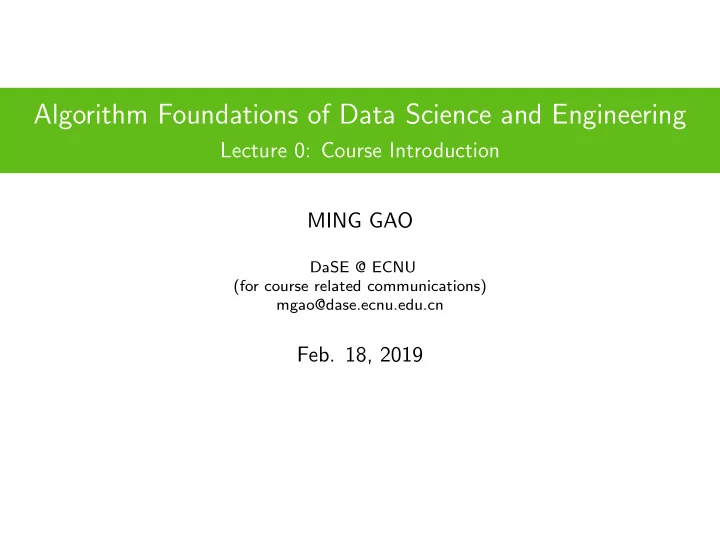

Algorithm Foundations of Data Science and Engineering Lecture 0: Course Introduction MING GAO DaSE @ ECNU (for course related communications) mgao@dase.ecnu.edu.cn Feb. 18, 2019
Outline Textbooks and References Requirements and Assessment Office Hour and Contact Information Overview of This Course What Is Data Science? Course Schedule Take-aways 2 / 18
Required sources Required sources � Ming Gao, Huiqi Hu, Lecture notes. � John Hopcroft and Ravindran Kannan, Foundations of Data Science. � Anand Rajaraman and Jeffrey D. Ullman, Mining of Massive Datasets. References � Daphne Koller and Nir Friedman, Probabilistic Graphical Models: Principles and Techniques. � Gilbert Strang, Linear Algebra and Its Applications(Fourth Edition). 3 / 18
Requirements 1. Slides and lecture notes will be posted 1-2 days before lecture, but 2. Students are expected to � take notes during lecture � read the assigned readings before and after the lecture � think through the answers of tutorial (a set of questions) every week before the lecture 3. Implement a technique published in the top venues, such as KDD, ICDM, SIGMOD, SIGIR, ACL, etc. (honestly and independently) 4 / 18
Assessment 5 / 18
Contact information Lecturer: GAO Ming—- � Office: Rm. East 115, Math. Building � Phone: 6223 2061 � Mobile: 189 1694 3299 � Email: mgao@sei.ecnu.edu.cn � TA: Yingnan Fu—- � Course homepage: http://dase.ecnu.edu.cn/mgao/teaching/ DataSci_2019_Spring/ADS.html � Research interests: � User profiling � Knowledge graph and knowledge engineering � Computational pedagogy � Streaming and social data mining 6 / 18
Data science and big data � How to understand big data? � Volume: 100PB and 20PB data daily processing for Baidu and Google, respectively; Alibaba and Tecent have data more than 100PB. � Velocity: Large Hadron Collider generates PB data in seconds; many streaming such as clickstream, log, RFID, Twitter, etc. #Trans. is almost 100,000 per second in Taobao during “Double 11”. � Variety: structured, semi-structured and non-structured, including text, logs, video, voice and image etc. � Value: interests, behaviors, trustworthiness, and preference, etc. � Fragmentation of information: � Telecom � E-commerce � Social media � Internet of things (IOT) � · · · 7 / 18
Birth of data science � Reasons � Challenges of 4V � Hardware updating � Open sources, including Hadoop, Spark, Storm, and so on. � Applications, such as E-commerce, sharing economy, industry 4.0, smart city, and intelligent education, etc. 8 / 18
What is data science? Definition Data science is an interdisciplinary field, which is a continuation of some of the data analysis fields such as mathematics, statistics, machine learning, data mining, and parallel computing, similar to Knowledge Discovery in Databases (KDD). Objective Data science goals to: � extract knowledge � insight from data in various forms, either structured or unstructured � help users to understand massive data 9 / 18
DS co-evolution � Data science was mentioned by John W. Tukey in 1962 (“The Future of Data Analysis” ). � Data science was defined by Peter Naur in 1974 (“Concise Survey of Computer Methods”) � Many data mining approaches were proposed in the 1980s of the 20th century. � In 1996, international federation of classification societies issue set up a conference, namely Data Science, Classification and Related Methods. � In June 2009, Nathan Yau published a paper talking about the rising of data science. � Data scientist is the sexiest job in the 21st century (Hal Varian on Sep. 2012). 10 / 18
Types of data scientists � Data developer: data acquisition, organization and management. � Data researcher: statisticians, social scientist, computer scientist, etc. � Data creative: experts in machine learning, data mining, and programming, etc., contributor in open-source community, � Data businessmen: project manager, Chief Data Officer (CDO) � Mixed/Generic type: deep-understand in business, professional in technology, good at programming, etc. 11 / 18
Why do we need to learn this course? Remarks 1. Most popular among new options added in 2016 are K-nearest neighbors, PCA, Random Forests, Optimization, Neural networks, Deep Learning, and Singular Value Decomposition 2. The biggest declines are Association rules, statistics, and Decision Trees 12 / 18
Course features Features 1. Algorithms for data science involve in many disciplines, such as data mining, machine learning, statistics, visualization, NLP, data management, optimization, and algebra, etc. 2. Tasks in data science problems are various in data types. 13 / 18
Four paradigms of scientific research � Experimental science � Theoretical science � Computational science � Data science? � It was firstly proposed by Jim Gray (a database researcher) in 2009. � The Forth Paradigm: Data-Intensive Scientific Discovery was wrote by Tony Hey (vice president of Microsoft) et al. in 2009. � Thus, the capability for big data processing is important to scientific researchers. 14 / 18
The shortage of data scientists 15 / 18
Schedule Background DS overview Randomized algorithm � Probabilistic inequality � Hashing algorithm � Sketch Statistics � Regression and regularization � Sampling � EM algorithm 16 / 18
Schedule Algebra � Eigenvalue computation � SVD and PCA � Matrix factorization Optimization � Integer programming � Submodular Graph � Random walk � Graph cut 17 / 18
Take-aways Course homepage: http: //dase.ecnu.edu.cn/mgao/teaching/ DataSci_2019_Spring/ADS.html Advices to learning algorithm foundations of data science and engineering � Not a reading course. � More than a programming course, though it is project-heavy � No standard answers 18 / 18
Recommend
More recommend